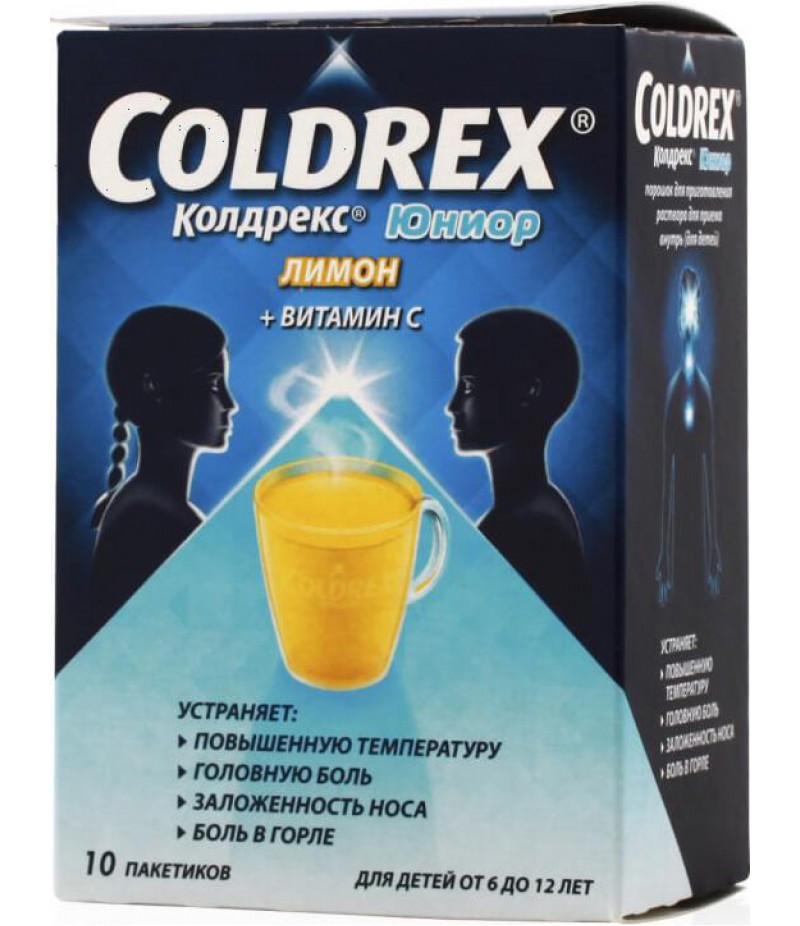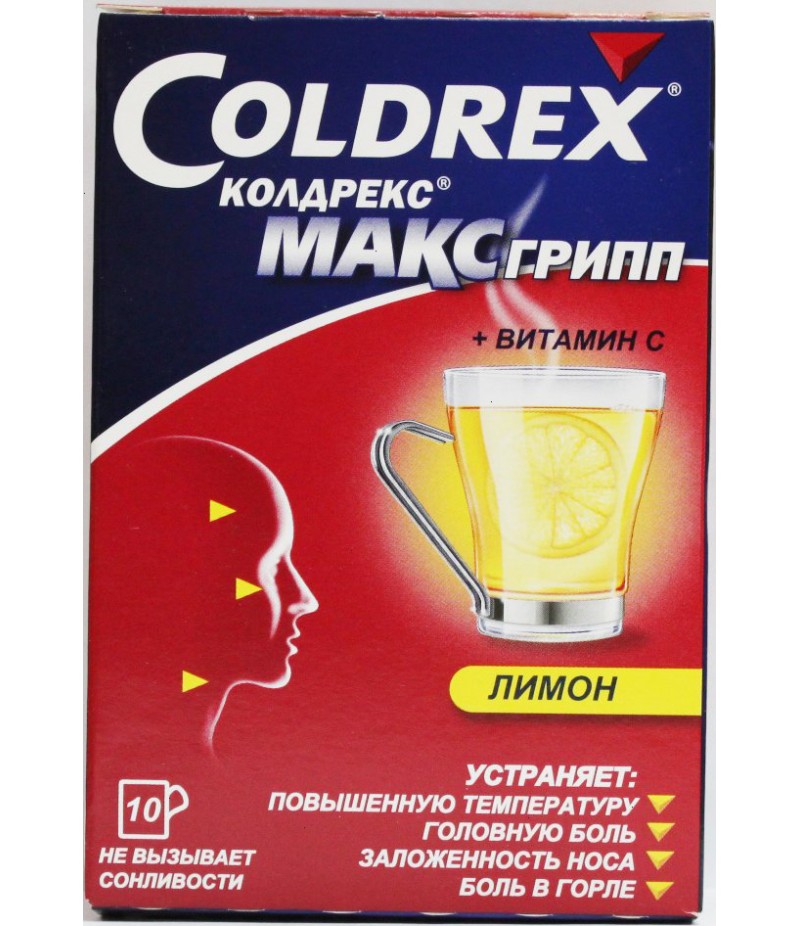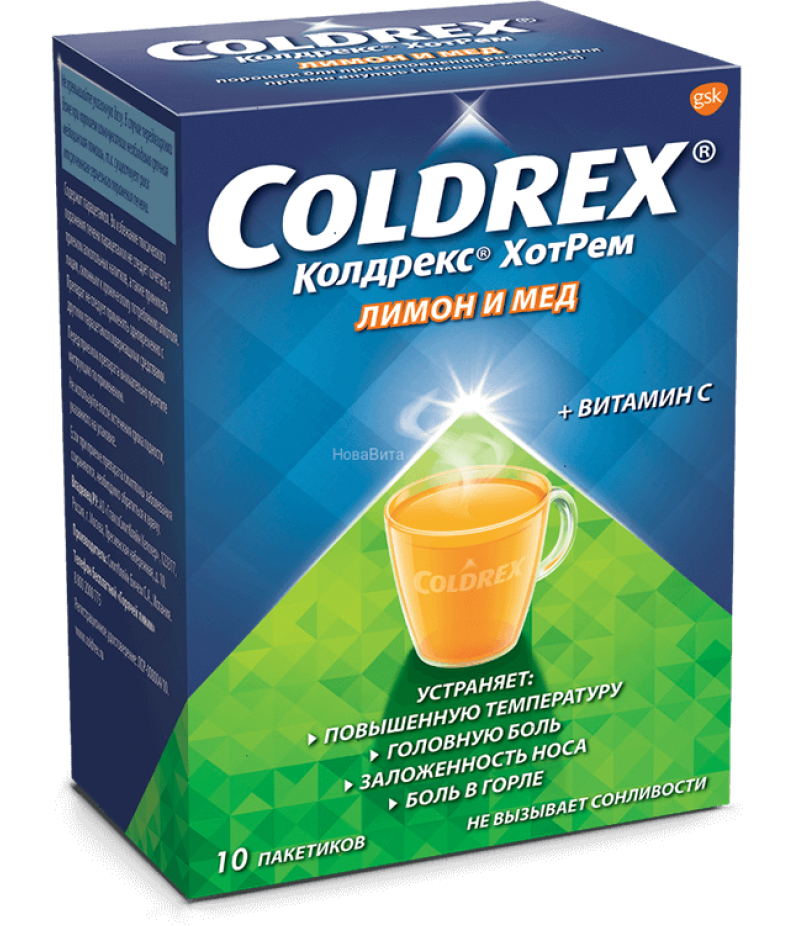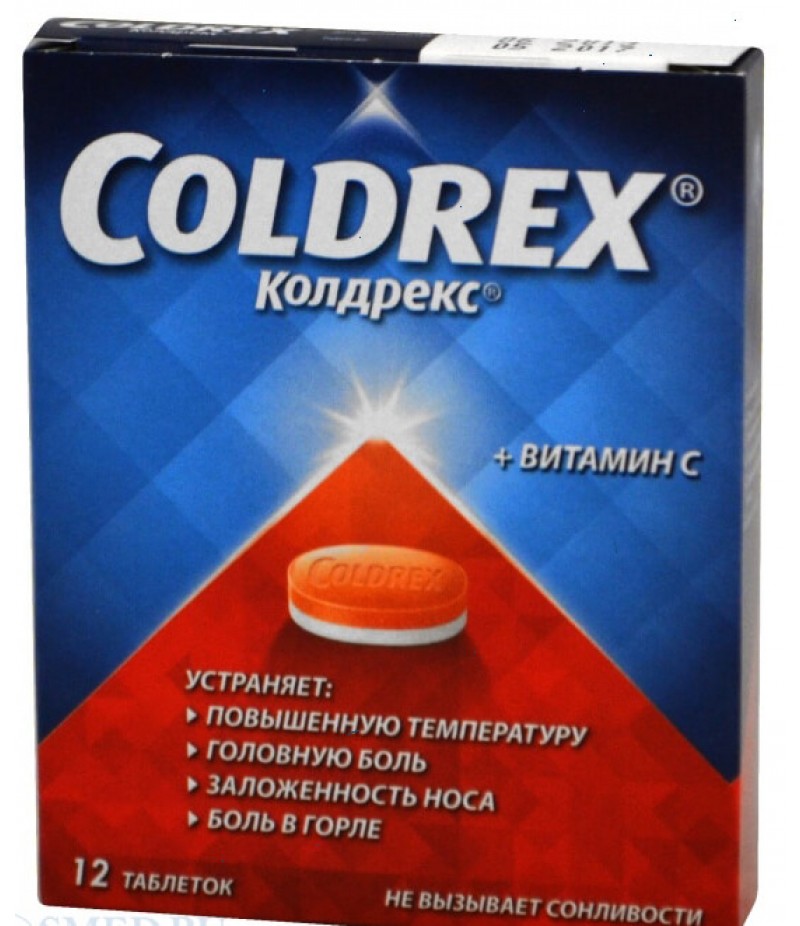Coldrex Junior powder #10
- $15.15
- 3 or more $14.99
- Availability:In Stock
Instruction for Coldrex JuniorReed more and buy Coldrex Junior hereForm of release, composition and packagingPowder for solution for oral administration (for children) is heterogeneous, from white to pale yellow, with the smell of..
Tags: powder
Instruction for Coldrex Junior
Reed more and buy Coldrex Junior here
Form of release, composition and packaging
Powder for solution for oral administration (for children) is heterogeneous, from white to pale yellow, with the smell of lemon; dissolved in 125 ml of hot water to form a cloudy solution from yellow to yellow-green color, which does not have a foam on the surface, with the smell of lemon; there may be a slight precipitate.
1 pack.
paracetamol 300 mg
phenylephrine hydrochloride 5 mg
ascorbic acid 20 mg
Auxiliary substances: sodium saccharinate - 21.5 mg, sodium cyclamate - 31.5 mg, citric acid - 340 mg, sodium citrate - 215 mg, corn starch - 100 mg, sucrose - 1862.5 mg, flavoring lemon 610399E - 100 mg, dye curcumin (E100) - 3.5 mg, silicon dioxide colloid - 1 mg.
3 g - bags made of laminate (10) - packs of cardboard.
pharmachologic effect
Combined drug for the symptomatic treatment of acute respiratory diseases.
Paracetamol has an antipyretic, analgesic effect.
Phenylephrine hydrochloride is a sympathomimetic, narrows the vessels of the nasal mucosa and paranasal sinuses, thereby reducing edema and facilitating nasal breathing.
Ascorbic acid replenishes the increased need for vitamin C for colds and flu.
Pharmacokinetics
Data on the pharmacokinetics of Coldrex® Junior are not available.
Indications for Coldrex Junior
To eliminate symptoms of acute respiratory disease and influenza in children aged 6-12 years, including:
Increased fever;
- headache;
- chills;
- pain in the joints and muscles;
- sensations of stuffy nose;
- pain in the sinuses of the nose and in the throat.
Dosing regimen
Children aged 6 to 12 years are prescribed 1 packet every 4 hours. Do not use more than 4 sachets within 24 hours. Do not exceed the indicated dose. The maximum duration of application is no more than 5 days. If symptoms persist, consult a doctor. The doctor determines the necessity of continuing the treatment individually.
The contents of 1 sachet pour into a mug, pour about 125 ml of hot water, stir until dissolved. If necessary, add cold water and sugar.
Side effects of Coldrex Junior
Determination of the frequency of side effects: very often (≥1/10), often (≥1 / 100 and <1/10), infrequently (≥1 / 1000 and <1/100), rarely (≥1 / 10,000 and <1 / 1000), very rarely (≥1 / 100,000 and <1/10 000).
In recommended doses, Coldrex Junior is usually well tolerated.
Paracetamol rarely has a side effect.
With prolonged use with excess of the recommended dose, hepatotoxic and nephrotoxic effects can be observed.
From the hemopoietic system: very rarely - thrombocytopenia.
Allergic reactions: rarely - skin rash, hives, allergic dermatitis; very rarely - anaphylaxis, hypersensitivity reactions, incl. angioedema, Stevens-Johnson syndrome.
On the part of the respiratory system: very rarely - bronchospasm in patients sensitive to acetylsalicylic acid and other NSAIDs.
From the digestive system: very rarely - nausea, vomiting, impaired liver function.
From the side of the central nervous system: very rarely - dizziness, headache, insomnia.
From the sense organs: rarely - mydriasis, an acute attack of glaucoma in most cases in patients with closed-angle glaucoma.
From the cardiovascular system: rarely - tachycardia, palpitations, increased blood pressure.
From the urinary system: very rarely - dysuria, urinary retention in patients with obstruction of the bladder outlet with prostatic hypertrophy.
In case of any undesirable reactions, the patient should consult a doctor.
Contraindications for Coldrex Junior
- hypersensitivity to the components of Coldrex Junior;
- severe liver disease;
- severe kidney disease;
- diseases of the hematopoiesis system;
- thyrotoxicosis;
- arterial hypertension;
- heart disease (pronounced stenosis of the aortic aorta, acute myocardial infarction, tachyarrhythmia);
- hyperplasia of the prostate;
- an angle-closure glaucoma;
- diabetes;
- genetic absence of glucose-6-phosphate dehydrogenase;
- deficiency of sugar / isomaltase, intolerance to fructose, glucose-galactose malabsorption, t. the preparation contains sucrose;
- simultaneous reception of tricyclic antidepressants, beta-blockers, MAO inhibitors and up to 14 days after their cancellation;
- A child up to 6 years old.
With caution should apply Coldrex Junior for benign hyperbilirubinemia, pheochromocytoma, peripheral vascular disease (Raynaud's syndrome).
Application for violations of liver function
Contraindications: severe liver dysfunction.
Application for violations of kidney function
Contraindications: severe renal dysfunction.
Use in children
Contraindication: children under 6 years.
Use in children older than 6 years is possible according to the dosing regimen.
special instructions for Coldrex Junior
The drug should not be taken concomitantly with other drugs containing paracetamol, as well as other non-narcotic analgesics (metamizole sodium), NSAIDs (acetylsalicylic acid, ibuprofen), with other agents to relieve cold and flu symptoms, sympathomimetics (such as decongestants, appetite suppressants , amphetamine-like psychostimulants), barbiturates, anticonvulsant drugs, rifampicin and chloramphenicol.
When performing tests for the determination of uric acid and blood glucose levels, the doctor should be informed of the use of Coldrex Junior. the drug may distort the results of laboratory tests evaluating the concentration of glucose and uric acid.
Before taking Coldrex Junior, consult a doctor in case:
- taking metoclopramide, domperidone (used to eliminate nausea and vomiting), or colestyramine, used to lower the concentration of cholesterol in the blood;
- taking medications to reduce blood clotting (for example, warfarin);
- Compliance with a diet with a reduced sodium content - each packet contains 0.12 g of sodium.
To avoid toxic damage to the liver, paracetamol should not be combined with preparations containing ethanol.
Impact on the ability to drive vehicles and mechanisms
In case of dizziness, the patient should refrain from driving vehicles or other potentially dangerous activities requiring concentration of attention and speed of psychomotor reactions.
Overdose
In case of an overdose of Coldrex Junior (even if you feel well), you should consider the risk of delayed signs of severe liver damage.
Symptoms caused by paracetamol: within 24 hours - pallor of the skin, decreased appetite, nausea, vomiting, abdominal pain. After 12-48 h, there may be signs of impaired liver function, signs of impaired glucose metabolism and metabolic acidosis.
In case of severe poisoning, severe hepatic insufficiency may develop, including hepatic encephalopathy, coma, and death. Acute renal failure with acute tubular necrosis, which is diagnosed by severe pain in the lumbar region, hematuria and proteinuria, can develop without a serious impairment of liver function. There are reports of cases of cardiac arrhythmias and pancreatitis in case of an overdose of paracetamol.
In the early period, the symptomatology can be limited only by nausea and vomiting and may not reflect the severity of the overdose or the risk of injury to the internal organs.
Treatment: during the first hour after the alleged overdose, it is advisable to administer the activated carbon inside. After 4 or more hours after the alleged overdose, a determination of the paracetamol concentration in the plasma is required (an earlier determination of the paracetamol concentration may be unreliable). A specific antidote for paracetamol poisoning is acetylcysteine. Treatment with acetylcysteine can be performed up to 24 hours after taking paracetamol, but the maximum hepatoprotective effect can be obtained in the first 8 hours after an overdose. After that, the effectiveness of the antidote drops sharply. If necessary, acetylcysteine can be administered iv. In the absence of vomiting, an alternative option (in the absence of the possibility of rapid receipt of inpatient care) is the appointment of methionine inside. Treatment of patients with severe impairment of liver function 24 hours after taking paracetamol should be done in conjunction with specialists from a toxicological center or specialized department of liver diseases.
Symptoms caused by phenylephrine: irritability, headache, dizziness, insomnia, increased blood pressure, nausea, vomiting, increased excitability, reflex bradycardia. In severe cases of overdose, it is possible to develop hallucinations, confusion, convulsions, arrhythmias.
Treatment: symptomatic therapy, with severe arterial hypertension, the use of alpha-blockers, such as phentolamine.
Symptoms due to ascorbic acid: ascorbic acid in high doses (more than 3000 mg) can cause temporary osmotic diarrhea and gastrointestinal disturbances, such as nausea, discomfort in the stomach. Manifestations of an overdose of ascorbic acid can be categorized as those that are caused by severe liver damage as a result of an overdose of paracetamol.
Treatment: symptomatic, forced diuresis.
Drug Interactions
Paracetamol, when taken for a long time, increases the effect of indirect anticoagulants (warfarin and other coumarins), which increases the risk of bleeding. Episodic intake of a single dose of the drug has no significant effect on the effect of indirect anticoagulants.
Inducers of microsomal oxidation enzymes in the liver (barbiturates, diphenin, carbamazepine, rifampicin, zidovudine, phenytoin, ethanol, flumecinol, phenylbutazone and tricyclic antidepressants) increase the risk of hepatotoxic effects in overdoses and simultaneous administration with paracetamol.
Inhibitors of microsomal oxidation (cimetidine) reduce the risk of hepatotoxic effects.
Paracetamol decreases the effectiveness of diuretic drugs.
Metoclopramide and domperidone are increased, and colestramine reduces the rate of absorption of paracetamol.
Paracetamol increases the effects of MAO inhibitors, sedatives, ethanol.
Phenylephrine when taken with MAO inhibitors may lead to an increase in blood pressure.
Phenylephrine reduces the effectiveness of beta-adrenoblockers and antihypertensive drugs, increases the risk of hypertension and cardiovascular disorders.
Tricyclic antidepressants enhance the sympathomimetic effect of phenylephrine, may increase the risk of developing
side effects from the cardiovascular system.
The simultaneous use of halothane with phenylephrine increases the risk of ventricular arrhythmia.
Phenylephrine reduces the hypotensive effect of guanethidine, which, in turn, enhances the alpha-adrenostimulating activity of phenylephrine.
Antidepressants, antiparkinsonics, antipsychotics, phenothiazine derivatives increase the risk of urinary retention, dry mouth, constipation.
Simultaneous administration of GCS with phenylephrine increases the risk of developing glaucoma.
When used simultaneously with digoxin and cardiac glycosides, there may be an increased risk of heart rhythm disturbances or heart attack.
Ascorbic acid with simultaneous application with iron preparations, due to its reducing properties, converts trivalent iron into bivalent iron, which improves its absorption.
With simultaneous application of ascorbic acid increases the excretion of iron in patients receiving deferoxamine.
When used simultaneously with barbiturates, primidone, excretion of ascorbic acid with urine increases.
Ascorbic acid in high doses can reduce the pH of the urine, which, when used at the same time, reduces the tubular reabsorption of amphetamine and tricyclic antidepressants.
With the simultaneous use of acetylsalicylic acid reduces the absorption of ascorbic acid by about a third.
With simultaneous use with warfarin, the effects of warfarin may be reduced.
With simultaneous use with tetracycline, the excretion of ascorbic acid with urine increases.
Terms and conditions of storage
Coldrex Junior should be stored out of reach of children at a temperature of no higher than 25 ° C. Shelf life - 3 years.
Conditions of leave from pharmacies
You can buy Coldrex Junior without a prescription.




